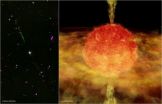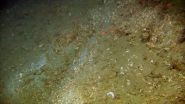(Press-News.org) Evidence that a star has recently engulfed a companion star or a giant planet has been found using NASA's Chandra X-ray Observatory. The likely existence of such a "cannibal" star provides new insight into how stars and the planets around them may interact as they age.
The star in question, known as BP Piscium (BP Psc), appears to be a more evolved version of our Sun, but with a dusty and gaseous disk surrounding it. A pair of jets several light years long blasting out of the system in opposite directions has also been seen in optical data. While the disk and jets are characteristics of a very young star, several clues -- including the new results from Chandra -- suggest that BP Psc is not what it originally appeared to be.
Instead, astronomers have suggested that BP Psc is an old star in its so-called red giant phase. And, rather than being hallmarks of its youth, the disk and jets are, in fact, remnants of a recent and catastrophic interaction whereby a nearby star or giant planet was consumed by BP Psc.
When stars like the Sun begin to run of nuclear fuel, they expand and shed their outer layers. Our Sun, for example, is expected to swell so that it nearly reaches or possibly engulfs Earth, as it becomes a red giant star.
"It appears that BP Psc represents a star-eat-star Universe, or maybe a star-eat-planet one," said Joel Kastner of the Rochester Institute of Technology, who led the Chandra study. "Either way, it just shows it's not always friendly out there."
Several pieces of information have led astronomers to rethink how old BP Psc might be. First, BP Psc is not located near any star-forming cloud, and there are no other known young stars in its immediate vicinity. Secondly, in common with most elderly stars, its atmosphere contains only a small amount of lithium. Thirdly, its surface gravity appears to be too weak for a young star and instead matches up with one of an old red giant.
Chandra adds to this story. Young, low-mass stars are brighter than most other stars in X-rays, and so X-ray observations can be used as a sign of how old a star may be. Chandra does detect X-rays from BP Psc, but at a rate that is too low to be from a young star. Instead, the X-ray emission rate measured for BP Psc is consistent with that of rapidly rotating giant stars.
The spectrum of the X-ray emission -- that is how the amount of X-rays changes with wavelength -- is consistent with flares occurring on the surface of the star, or with interactions between the star and the disk surrounding it. The magnetic activity of the star itself might be generated by a dynamo caused by its rapid rotation. This rapid rotation can be caused by the engulfment process.
"It seems that BP Psc has been energized by its meal," said co-author Rodolfo (Rudy) Montez Jr., also from the Rochester Institute of Technology.
The star's surface is obscured throughout the visible and near-infrared bands, so the Chandra observation represents the first detection at any wavelength of BP Psc itself.
"BP Psc shows us that stars like our Sun may live quietly for billions of years," said co-author David Rodriguez from UCLA, "but when they go, they just might take a star or planet or two with them."
Although any close-in planets were presumably devastated when BP Psc turned into a giant star, a second round of planet formation might be occurring in the surrounding disk, hundreds of millions of years after the first round. A new paper using observations with the Spitzer Space Telescope has reported possible evidence for a giant planet in the disk surrounding BP Psc. This might be a newly formed planet or one that was part of the original planetary system.
"Exactly how stars might engulf other stars or planets is a hot topic in astrophysics today," said Kastner. "We have many important details that we still need to work out, so objects like BP Psc are really exciting to find."
INFORMATION:
These results appeared in The Astrophysical Journal Letters. Other co-authors on the study were Nicolas Grosso of the University of Strasbourg, Ben Zuckerman from UCLA, Marshall Perrin from the Space Telescope Science Institute, Thierry Forveille of the Grenoble Astrophysics Laboratory in France and James Graham from University of California, Berkeley.
NASA's Marshall Space Flight Center in Huntsville, Ala., manages the Chandra program for NASA's Science Mission Directorate in Washington. The Smithsonian Astrophysical Observatory controls Chandra's science and flight operations from Cambridge, Mass.
Chandra finds evidence for stellar cannibalism
2010-09-14
ELSE PRESS RELEASES FROM THIS DATE:
Molecule identified that increases survival of stomach cancer patients
2010-09-14
"The high presence of microRNA 451 enhances the response to treatment with chemo-radiotherapy and increases the survival of patients with stomach cancer", explained Dr. Jesús García-Foncillas, chief researcher of the Pharmacogenomics Laboratory at the Applied Medical Research Centre (CIMA) and Director of Oncology at the University Hospital of Navarra. This was one of the results presented at the IV Congress of the Spanish Society for Pharmacogenetics and Pharmacogenomic, recently held at CIMA.
Pharmacogenetics studies the genetic bases determining the response of an ...
New current meter provides answers for lobster industry, oyster farmers, scientists
2010-09-14
NARRAGANSETT, R.I. – September 14, 2010 – When a federal fisheries scientist sought to learn how ocean currents affect the catch rate of lobsters, he turned to a University of Rhode Island oceanographer who had developed an innovative and inexpensive meter for measuring currents near the bottom of bays, rivers and other shallow waters.
So did aquaculture farmers in Rhode Island looking to identify the best site for farming oysters, Cape Cod officials interested in understanding tidal fluctuations in Waquoit Bay, and students at Cohasset (Mass.) High School studying circulation ...
Why 'scientific consensus' fails to persuade
2010-09-14
Suppose a close friend who is trying to figure out the facts about climate change asks whether you think a scientist who has written a book on the topic is a knowledgeable and trustworthy expert. You see from the dust jacket that the author received a Ph.D. in a pertinent field from a major university, is on the faculty at another one, and is a member of the National Academy of Sciences. Would you advise your friend that the scientist seems like an "expert"?
If you are like most people, the answer is likely to be, "it depends." What it depends on, a recent study found, ...
New American Chemical Society podcast: Big building blocks from nanoparticles
2010-09-14
WASHINGTON, Sept. 14, 2010 — A new genre of construction materials, made with particles barely 1/50,000th the width of a human hair, is about to play a big role in the building of homes, offices, bridges, and other structures, according to the latest episode in the American Chemical Society's (ACS) award-winning podcast series, "Global Challenges/Chemistry Solutions."
A new Global Challenges podcast and website is highlighting both the potential benefits of these nanomaterials in improving construction materials and the need for guidelines to regulate their use and ...
First US trial of bone-marrow stem cells for heart attack patients proves safe
2010-09-14
The first randomized, placebo-controlled U.S. clinical trial to assess the use of bone marrow-derived mononuclear cells (BMC) in patients after a ST-elevation myocardial infarction (STEMI; severe heart attack) demonstrated a strong safety profile for this cell therapy, based on phase 1 results published in the September issue of the American Heart Journal.
"The use of adult stem cells, derived from the patient's own bone marrow, presents a potential new type of therapy to benefit individuals after they suffer a heart attack," says the study's principal investigator Jay ...
Women more likely than men to accept global warming
2010-09-14
EAST LANSING, Mich. — Women tend to believe the scientific consensus on global warming more than men, according to a study by a Michigan State University researcher.
The findings, published in the September issue of the journal Population and Environment, challenge common perceptions that men are more scientifically literate, said sociologist Aaron M. McCright.
"Men still claim they have a better understanding of global warming than women, even though women's beliefs align much more closely with the scientific consensus," said McCright, an associate professor with ...
Watercress may 'turn off' breast cancer signal
2010-09-14
The research, unveiled at a press conference today (14 September 2010), shows that the watercress compound is able to interfere with the function of a protein which plays a critical role in cancer development.
As tumours develop they rapidly outgrow their existing blood supply so they send out signals which make surrounding normal tissues grow new blood vessels into the tumour which feed them oxygen and nutrients.
The research, led by Professor Graham Packham of the University of Southampton, shows that the plant compound (called phenylethyl isothiocyanate) found ...
Researchers nationwide ask for new focus on 'sudden death' heart disorder
2010-09-14
(PHILADELPHIA) An abrupt, fatal heart attack in a young athlete on the playing field is a tragedy destined to repeat itself over and over until more is understood about hypertrophic cardiomyopathy (HCM), a genetic disorder that is the most common cause of sudden death in young people but which affects people of all ages. So says a task force of cardiologists and cardiac biologists, headed by Thomas L. Force, M.D., James C. Wilson Professor of Medicine at Thomas Jefferson University, in the September 14th online edition of the journal Circulation.
Their special report ...
Human impacts on the deep seafloor
2010-09-14
Scientists have for the first time estimated the physical footprint of human activities on the deep seafloor of the North East Atlantic. The findings published in the journal PLoS ONE reveal that the area disturbed by bottom trawling commercial fishing fleets exceeds the combined physical footprint of other major human activities considered.
The deep seafloor covers approximately 60% of Earth's surface, but only a tiny fraction of it has been studied to date. Yet as technology advances and resources from relatively shallow marine environments are depleted, human impacts ...
Global fisheries research finds promise and peril
2010-09-14
Global fisheries, a vital source of food and revenue throughout the world, contribute between US$225-$240 billion per year to the worldwide economy, according to four new studies released today. Researchers also concluded that healthier fisheries could have prevented malnourishment in nearly 20 million people in poorer countries.
This first comprehensive, peer-reviewed estimate of the global economic contribution of fisheries was published online today in four papers as part of a special issue of the Journal of Bioeconomics.
This research, conducted by the University ...



